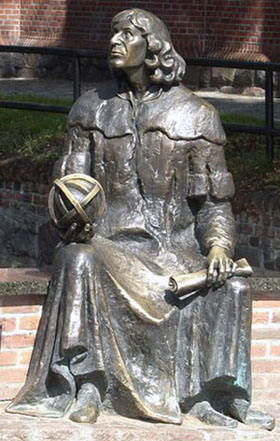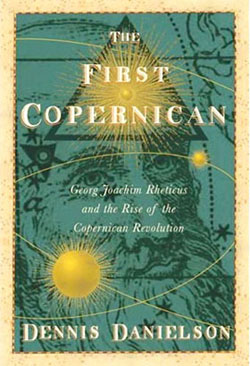Rheticus and Copernicus
Today, Copernicus' prophet. The University of Houston's College of Engineering presents this series about the machines that make our civilization run, and the people whose ingenuity created them.
Late in Copernicus' life, a young man arrived at his home in Frauenburg, Poland. The year was 1539, and twenty-five-year-old mathematics professor Georg Rheticus was on leave from the University of Wittenberg where Martin Luther was his older colleague. Rheticus was an enthusiastic Lutheran Protestant. Copernicus was Catholic and the local canon of the Cathedral in Cracow.
Yet in those turbulent early years of the Protestant Reformation, religious differences are not a part of our story, at least not yet. Rheticus, fascinated by astronomy, was on a tour visiting the great astronomers of Central Europe, ending with Copernicus.
 Copernicus had done many things. He'd studied medicine and canon law. He'd written extensively on economics. He was first to state what we call Gresham's Law, "Bad money drives out the good." He gave us a theory of just pricing. And his warnings against the inflationary printing of money were based on ideas that sounded a lot like those of Adam Smith, three centuries later.
Copernicus had done many things. He'd studied medicine and canon law. He'd written extensively on economics. He was first to state what we call Gresham's Law, "Bad money drives out the good." He gave us a theory of just pricing. And his warnings against the inflationary printing of money were based on ideas that sounded a lot like those of Adam Smith, three centuries later.
Yet his underlying passion was astronomy. He'd lectured only briefly on the subject -- never tutored a student. As for his sun-centered solar system, he'd published only a short tract long before -- in 1514. And it included none the math behind the idea.
Still, his astronomical knowledge was well-known. And now Rheticus appeared, eager to learn. He stayed for two years. The two became very close. Each admired the other's honest dedication to learning.
Copernicus had drafted a full treatise on his ideas, but he was sitting on it. Neither the church nor the public was ready to see the center of the universe anywhere but at the center of Earth. It took Rheticus' passion for the idea to get Copernicus to finish the book -- titled, On the Revolutions of the Heavenly Spheres.
Copernicus entrusted the finished manuscript to Rheticus, who took it off to a publisher in Nürnberg. Rheticus left the complex typesetting, under the eye of a noted Nürnberg theologian. The actual printing was done very well, but then the theologian added an anonymous introductory letter to the text. It said that, although Earth did not reallyorbit the Sun, the mathematics becomes much simpler if we simply imagine that it does.
When Rheticus saw that, he was outraged. Today we find, in every copy that he ever held, a livid X slashed across that page in red crayon. And yet, that letter probably allowed Copernicus' ideas to spread and touch our world as few other ideas ever did.
As for Copernicus, he suffered a stroke before he saw the finished book. It arrived as he lay unable to speak. Just hours before he died, his friends put the title page where he could see it. And we're left to wonder: could he still comprehend? And did he know what forces he had unleashed -- with the help of a young man who clearly was aware that nothing would ever be the same again?
I'm John Lienhard at the University of Houston, where we're interested in the way inventive minds work.
 D. Danielson, The First Copernican: Georg Joachim Rheticus and the Rise of the Copernican Revolution. (New York: Walker & Company, 2006).
D. Danielson, The First Copernican: Georg Joachim Rheticus and the Rise of the Copernican Revolution. (New York: Walker & Company, 2006).
E. Rosen, Rheticus, George Joachim. Dictionary of Scientific Biography, C.C. Gillispie, ed., Vol. XI (New York: Charles Scribner's Sons, 1950): pp. 395-398.
See also this online Copernicus biography from Stanford University and this Rheticus biography from the University of St. Andrews, Scotland.
Photo of the Copernicus statue at Olsztyn is courtesy of Wikipedia commons.